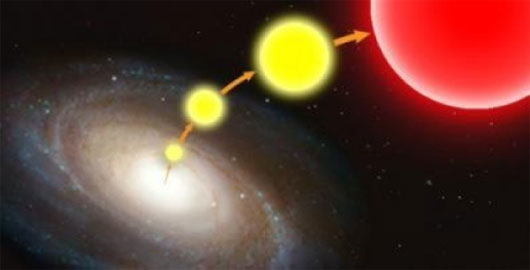Detected the defected star group in the Milky Way
American students find a group of stars that move so quickly that they can escape the Milky Way in the future.
The Milky Way - the convergence of trillions of stars and a multitude of gas clouds - rotates around its axis after 200 million years. If viewed from a distance, we feel every object in the Milky Way arranged in an order and their position does not seem to change when the Milky Way rotates around the axis. But when looking closely, astronomers from Vanderbilt University in the United States discovered 20 "uncanny" stars moving faster than other stars. Their speed reached more than 1.6 million km / h - large enough for them to escape the Milky Way at some point in the future, Science Daily reported.

Illustration of a super-fast star moving away from the center of the galaxy.(Photo: dailygalaxy.com)
Super speed stars are quite small. Their size is only equivalent to the sun. But another strange thing is that they don't seem to come from the center of the Milky Way.
"They are very different from the stars we have discovered before, because their initial position is not the center of the galaxy," said Lauren Palladino, a student at Vanderbilt University.
Palladino and other students accidentally discovered 20 super-speed stars when they mapped the Milky Way by calculating the orbits of sun-like stars in a statistical program of stars and galaxies over 1 / 4 sky.
"Escape from the galaxy is extremely difficult for all stars. They can only do so through the action of a supermassive black hole at the core of the galaxy. That means you have to find out where the star has been. The super-fast star group that we discovered does not form at the center of the Milky Way so it is possible that they are a super-fast star that scientists do not know yet. " Professor Kelly Holley-Bockelmann, who guides Palladino, commented.
Astronomers calculate that, to escape a galaxy, a star must reach a speed of more than 1.6 million km / h relative to the velocity of the galaxy itself. If it reaches that speed, it will overcome the gravitational pull of the galaxy. The black hole at the Milky Way core is about 4 billion solar masses - large enough to create a powerful gravitational force capable of drawing stars towards it at tremendous speeds.
Most super-speed stars are a part of a binary star that falls into the sphere of influence of a black hole. When a star rushes toward the black hole, the star falls away from the black hole with tremendous velocity. Until now astronomers have discovered 18 blue super-speed stars that were part of a binary star system.
- Strange star groups move rapidly to disturb the Milky Way
- Close up of the Milky Way's
- The mysterious age of the mysterious star
- The fastest star in the Milky Way
- The star flies more than 1,000 km / sec after 'hiding' from the black hole
- The 'lonely star' was kicked out of the Milky Way, forever in nothingness
- The biggest star in the Milky Way is forming
- Discover the farthest star in the Milky Way
- 'Crazy star' was thrown out of the Milky Way
- Fun little-known facts about the Milky Way
- 360-degree portrait of the Milky Way
- Incidentally the star forms near a black hole
 Van Allen's belt and evidence that the Apollo 11 mission to the Moon was myth
Van Allen's belt and evidence that the Apollo 11 mission to the Moon was myth The levels of civilization in the universe (Kardashev scale)
The levels of civilization in the universe (Kardashev scale) Today Mars, the sun and the Earth are aligned
Today Mars, the sun and the Earth are aligned The Amazon owner announced a secret plan to build a space base for thousands of people
The Amazon owner announced a secret plan to build a space base for thousands of people